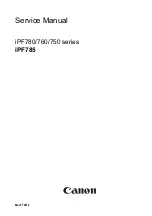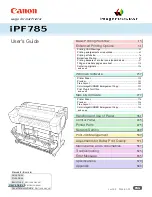
7) Description of input/output signals
Compatible Mode
Data Strobe [Input]
This signal is used to read DATA1 to DATA8. The signal becomes valid after the
BUSY signal goes Low and the printer outputs an ACKNLG signal. This signal is
normally High. After it goes Low, the printer receives data. When the signal
remains Low, the printer does not operate until it goes High.
Data1 to 8 [Input]
The printer receives data with the DATA STROBE signal.
The state of each bit of the signal must be maintained for at least 0.5µs from the
rising edge of the DATA STROBE signal.
Acknlg [Output]
This signal is a response signal to the DATA STROBE signal.
The host computer does not send the next DATA STROBE signal until this signal is
sent.
When the power is turned on or the BUSY signal goes Low for the input of the INIT
signal, this signal is sent regardless of the DATA STROBE signal.
Busy [Output]
When this signal is High, the printer is BUSY; when Low, the printer is READY.
The printer receives data at least 1 Byte when Data Stobe signal is input in the case
Busy signal goes to "H" regardless of receiving data.
The signal is High in the following cases:
• When receiving data
• When input buffer is full
• When INIT signal is input
• When carriage is in cartridge replacement position
• During manual cleaning
• When an error occurs (paper-out, paper jam, etc.)
• During soft power on/off sequence
• During internal initialization
PE [Output]
This signal goes High when the printer cannot feed paper. The BUSY signal goes
High and the SELECT and FAULT signals go Low.
This signal goes Low when the reset key was pressed and paper is loaded and fed.
The FAULT and SELECT signals then go from Low to High.
If paper is not ejected (paper jam) after an eject operation, this signal and the BUSY
signal go High, and the SELECT and FAULT signals go Low. In this case, the signals
do not change even if the paper is removed manually.
Select [Output]
The printer is READY when this signal is High.
This signal goes Low when an error occurs (paper-out, paper jam, etc.) or when the
carriage is in the cartridge replacement position.
Fault signal goes to low 50ms after Busy signal goes to high.
Auto Feed XT [Input]
This signal is only used for the transition from compatible mode to negotiation mode.
Part 2: Product Specifications
BJC-7100
2-14
Summary of Contents for BJC-7100
Page 2: ...1098 AB 5 00 0 ...
Page 3: ......
Page 14: ......
Page 16: ......
Page 32: ...Part 1 Safety and Precautions BJC 7100 1 16 This page intentionally left blank ...
Page 34: ......
Page 54: ......
Page 80: ......
Page 130: ...Part 4 Technical Reference BJC 7100 4 50 This page intentionally left blank ...
Page 132: ......
Page 178: ...Part 5 Maintenance BJC 7100 5 46 This page intentionally left blank ...
Page 184: ......
Page 185: ...PRINTED IN JAPAN IMPRIME AU JAPON CANON INC The printing paper contains 70 waste paper ...
















































